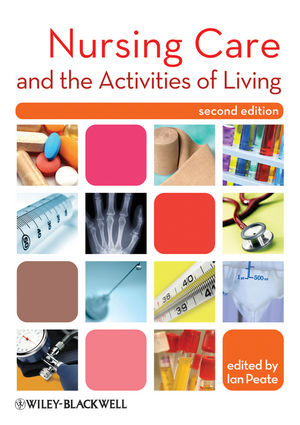Nursing Care and the Activities of Living, 2nd EditionISBN: 978-1-4051-9458-7
Paperback
328 pages
August 2009, Wiley-Blackwell
 |
||||||
Acknowledgements.
Introduction – Ian Peate.
1 The Nature of Nursing (Lynn Quinlivan).
Introduction.
The Nursing and Midwifery Council.
Registration and professional accountability.
Standards of conduct and performance.
Maintenance of a register of nurses and midwives.
Duty of care.
Fitness to practise.
Nurses and accountability.
Nursing hierarchy.
Government directives.
The structure of the NHS in England.
The structure of the NHS in Scotland.
The structure of the NHS in Wales.
The structure of the NHS in Northern Ireland.
Conclusions.
References.
2 Safeguarding Vulnerable Adults (Victorial Darby).
Introduction.
Defining a vulnerable adult and abuse.
Ethics and safeguarding the vulnerable adult.
Policies and legislation for safeguarding the vulnerable adult.
Safeguarding vulnerable adults from unprofessional nurses.
Fitness to practise panels.
Interprofessional collaboration.
Reporting suspicions of abuse as a nurse.
Assessing the seriousness of abuse.
Reporting suspicions of abuse as a student nurse.
Conclusions.
References.
3 Assessing Needs and the Nursing Process (Lynda Sibson).
Introduction.
Models of nursing.
Activities of living.
Organisation of nursing care.
Nursing practice.
Nursing history.
Elements in nursing.
Theories, concepts and models.
Nursing process.
Conclusions.
References.
4 Promoting Safety (Janet G. Migliozzi).
Introduction.
Risk assessment.
Common risks in health care.
Common factors affecting patient safety.
Minimising the risk of medication error.
Minimising the risk of falls.
Minimising the risk of health care-associated infection.
Conclusions.
References.
5 Communicating Effectively (David Briggs).
Introduction.
Talking to patients, carers and colleagues effectively and clearly.
conveying and receiving the intended message.
Facilitating patients and their carers to communicate effectively.
The importance of listening effectively.
Potential communication difficulties.
The differing methods of communication used by individuals.
Communicating with people from different cultures.
Coping in a very specific and difficult situation.
Using body language effectively.
Using the electronic means of distributing information.
The ability to know when someone needs to know a piece of information.
Information and record keeping.
Communication and reflective practice.
Conclusions.
References.
6 Eating and Drinking: Fluid and Nutritional Care in Practice (Jane Say).
Introduction.
Nutritional issues and clinical practice.
Obesity.
Undernutrition.
Disease-related factors.
Non-disease-related factors.
Providing nutritional care in practice.
Screening/assessment to identify patients’/clients’ nutritional needs.
Body mass index.
Weight loss.
Recent dietary intakes.
Stress factors/nature of current illness.
Further action, assessment and referral.
Planning, implementation and evaluation of nutritional care.
Monitoring and re-screening.
Factors that affect nutritional care: the hospital and care environment.
Assistance with eating and drinking.
Food provision.
Nutritional support.
Improving oral intakes.
Oral supplements.
Enteral (or tube) feeding.
Specific nursing care associated with enteral feeding.
Parenteral nutrition.
Fluid management in clinical practice.
Clinical assessment of fluid balance.
Conclusion.
References.
7 Elimination – Alimentary and Urinary Tracts (Muralitharan Nair).
Introduction.
The oral cavity.
Pharynx.
Oesophagus.
Stomach.
Small intestine.
Large intestine.
The accessory organs.
Care of patients with gastrointestinal disorders.
Renal system.
The prostate gland.
Care of patients with urological disorders.
Conclusions.
References.
8 Breathing (Sean Mallon).
Introduction.
Structure and function of the respiratory tract.
Assessment of respiration.
Measuring respiratory rate, depth and rhythm.
Respiratory sounds.
Observation of cough and sputum.
Other methods of assessing respiratory function.
Aerosols and nebulisers.
Some common respiratory diseases.
Conclusions.
References.
9 Personal Cleansing and Dressing (Laureen Hemming).
Introduction.
Anatomy and physiology of the skin.
Cultural perspectives.
Nursing care.
Cleansing products.
Conclusions.
References.
10 An Ergonomic Approach to Safe Manual Handling (Kim Walter).
Introduction.
Principles of safe handling and the biomechanics of back injury.
Ergonomics.
Risk assessment.
Controversial techniques and hazardous tasks.
The management of bariatric patients.
Conclusions.
References.
11 Maintaining Body Temperature (Guy Dean).
Introduction: temperature and metabolism.
Control of temperature.
Factors influencing body temperature.
Body heat considerations.
Taking the temperature.
Body temperature.
Hypothermia.
Conclusions.
References.
12 Work and Leisure (Jackie Hulse).
Introduction.
Family life and gender.
Employment and inequalities.
Unemployment.
Health and safety.
Informal carers.
Illness and employment.
Retirement.
Leisure.
Conclusions.
References.
13 The Sexual Being (Ian Peate).
Introduction.
Policy and key drivers.
Defining key terms.
Assessing sexual health.
Approaches to assessment.
Older people’s sexuality and health.
Sexual problems.
Barriers to sexual discussion.
Conclusions.
References.
14 Sleep and Rest (Debbie Davies).
Introduction.
What is sleep?
Physiology of sleep.
The states and stages of sleep.
Theories of the need for sleep.
Dreaming and sleep.
Sleep needs over the life cycle.
Factors influencing sleep.
Common primary sleep disorders.
Promoting sleep.
Nursing assessment.
Planning care.
Implementing care.
Evaluation.
Conclusions.
References.
15 Death and Dying (Mary Greeno).
Introduction.
Death and dignity.
Palliative care.
Where to die.
Some of the losses a dying patient or the family may experience.
Family involvement.
The needs of the dying patient.
Good practice in caring for patients and relatives/friends before death.
Signs of approaching death.
Procedures after death.
Last offices.
Cultural and religious beliefs.
Breaking bad news.
Conclusions.
References.
Appendix: Normal Values.
Index.



